
Validation of calibration software – as required by ISO 17025, for example – is a topic that people don’t like to talk about. Often there is uncertainty about the following: Which software actually must be validated? If so, who should look after it? Which requirements must be satisfied by validation? How do you do it efficiently and how is it documented? The following blog post explains the background and gives a recommendation for implementation in five steps.
In a calibration laboratory, software is used, among other things, from supporting the evaluation process, up to fully automated calibration. Regardless of the degree of automation of the software, validation always refers to the complete processes into which the program is integrated. Behind validation, therefore, is the fundamental question of whether the process of calibration fulfills its purpose and whether it achieves all its intended goals, that is to say, does it provide the required functionality with sufficient accuracy?
If you want to do validation tests now, you should be aware of two basic principles of software testing:
- Full testing is not possible.
- Testing is always dependent on the environment.
The former states that the test of all possible inputs and configurations of a program cannot be performed because of the large number of possible combinations. Depending on the application, the user must always decide which functionality, which configurations and quality features must be prioritised and which are not relevant for him.
Which decision is made, often depends on the second point – the operating environment of the software. Depending on the application, practically, there are always different requirements and priorities of software use. There are also customer-specific adjustments to the software, such as regarding the contents of the certificate. But also the individual conditions in the laboratory environment, with a wide range of instruments, generate variance. The wide variety of requirement perspectives and the sheer, endless complexity of the software configurations within the customer-specific application areas therefore make it impossible for a manufacturer to test for all the needs of a specific customer.
Correspondingly, taking into account the above points, the validation falls onto the user themself. In order to make this process as efficient as possible, a procedure fitting the following five points is recommended:
- The data for typical calibration configurations should be defined as “test sets”.
- At regular intervals, typically once a year, but at least after any software update, these test sets should be entered into the software.
- The resulting certificates can be compared with those from the previous version.
- In the case of a first validation, a cross-check, e.g. via MS Excel, can take place.
- The validation evidence should be documented and archived.
WIKA provides a PDF documentation of the calculations carried out in the software.
Note
For further information on our calibration software and calibration laboratories, visit the WIKA website.

